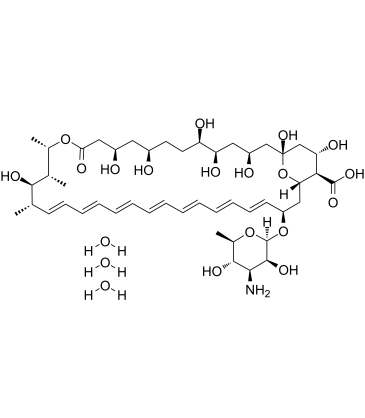1202017-46-6
| Name | Amphotericin B trihydrate |
|---|
| Description | Amphotericin B trihydrate, a polyene antibiotic, is first isolated from fermenter cultures of Streptomyces nodosus. Amphotericin B trihydrate also possesses antileishmanial activity[1][2]. |
|---|---|
| Related Catalog | |
| In Vitro | Amphotericin B interacts with cholesterol, the major sterol of mammal membranes, thus limiting the usefulness of Amphotericin B due to its relatively high toxicity. Amphotericin B is dispersed as a pre-micellar or as a highly aggregated state in the subphase[4]. Amphotericin B only kills unicellular Leishmania promastigotes (LPs) when aqueous pores permeable to small cations and anions are formed. Amphotericin B (0.1 mM) induces a polarization potential, indicating K+ leakage in KCl-loaded liposomes suspended in an iso-osmotic sucrose solution. Amphotericin B (0.05 mM) exhibits a nearly total collapse of the negative membrane potential, indicating Na+ entry into the cells[3]. |
| In Vivo | Amphotericin B results in prolonging the incubation time and decreasing PrPSc accumulation in the hamster scrapie model. Amphotericin B markedly reduces PrPSc levels in mice with transmissible subacute spongiform encephalopathies (TSSE)[4]. Amphotericin B exerts a direct effect on Plasmodium falciparum and influences eryptosis of infected erythrocytes, parasitemia and hostsurvival in murine malaria. Amphotericin B tends to delay the increase of parasitemia and significantly delays host death plasmodium berghei-infected mice[5]. |
| References |
[1]. A Lemke, et al. Amphotericin B Appl Microbiol Biotechnol. 2005 Aug;68(2):151-62. |
| Molecular Formula | C47H79NO20 |
|---|---|
| Molecular Weight | 978.12 |
